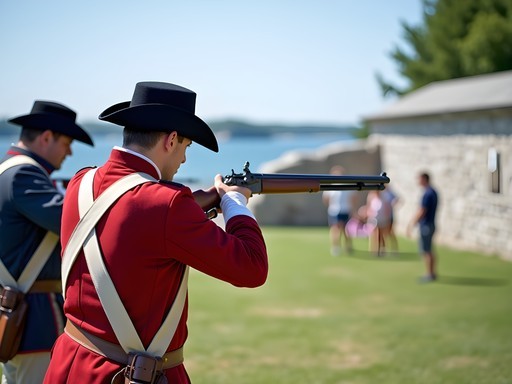Disclosure: This article contains affiliate links. We may earn a commission from purchases at no extra cost to you, which helps our travel content.
The gentle clip-clop of hooves against limestone streets replaced the familiar hum of engines as our ferry docked at Mackinac Island. Having explored coastal communities from the Outer Hebrides to Lofoten, I wasn't prepared for how this small American island would captivate me. Situated where Lake Huron meets Lake Michigan, this 3.8-square-mile haven feels suspended in time—not just because motor vehicles were banned in 1898, but because here, traditions aren't merely preserved; they're lived daily. As someone who's dedicated my career to understanding how communities maintain their cultural connections to water, Mackinac Island offered a fascinating case study of an economy and identity built around Great Lakes maritime heritage. With my camera ready and notebook in hand, I spent a glorious summer weekend exploring this living museum where 19th-century charm meets modern hospitality, all while surrounded by the azure waters that have shaped its unique story.
Fort Mackinac: Where History Breathes
Standing atop the limestone bluff overlooking the Straits of Mackinac, I couldn't help but think how this strategic position has witnessed the ebb and flow of nations. Fort Mackinac's white stone walls tell stories of British, French, and American control—each leaving distinct imprints on the island's cultural tapestry.
Built by the British during the American Revolution in 1780, the fort offers more than just spectacular views. As I wandered through the fourteen original buildings, each meticulously restored, costumed interpreters brought history to vibrant life. The crack of rifle demonstrations echoed across the parade ground, startling a flock of gulls into flight over the harbor below.
'The Great Lakes were America's first highways,' explained a young interpreter dressed in an 1880s military uniform, as he demonstrated how soldiers loaded their weapons. 'Whoever controlled Mackinac controlled the fur trade and shipping routes between the eastern seaboard and the resource-rich west.'
What struck me most was how the fort engages visitors of all ages. Children eagerly participated in the Junior Ranger program, while their parents marveled at the officers' stone quarters and the stunning views from the stone terrace. Unlike many historical sites I've visited globally, Fort Mackinac balances education with entertainment masterfully—making history accessible rather than academic.
Before visiting, I'd researched the site extensively with my illustrated history book, which proved invaluable for understanding the strategic significance of this limestone fortress. The book's vintage photographs gave me perspective on how remarkably preserved the fort remains today.

💡 Pro Tips
- Purchase fort tickets online to skip the queue, especially during peak summer season
- Attend the daily rifle firing demonstrations which typically happen at 11:30am, 1:30pm, and 3:30pm
- Bring binoculars to fully appreciate the panoramic views of the Straits of Mackinac from the fort's position
Carriage Tours: The Island's Heartbeat
There's something profoundly calming about exploring an island where the fastest vehicle is powered by hooves rather than horsepower. Mackinac Island's commitment to remaining car-free since 1898 isn't just a quaint tourist attraction—it's a deliberate preservation of pace and perspective that feels increasingly precious in our accelerated world.
I opted for the classic horse-drawn carriage tour, settling into the polished wooden seats as our guide, a fifth-generation islander named Sarah, took the reins. 'My great-great-grandfather drove these same routes,' she told us, flicking the reins gently. 'Though back then, he was delivering ice and mail, not stories.'
As we clip-clopped along Lake Shore Road, the juxtaposition of Victorian cottages against the vast blue of Lake Huron reminded me of coastal communities I've documented in Scotland's Outer Hebrides—places where water shapes not just geography but identity. The carriage swayed rhythmically as we passed Arch Rock, a natural limestone arch that stands 146 feet above the shoreline.
What makes these tours special isn't just the novelty of horse-drawn transportation, but the intimate knowledge shared by the drivers. Sarah pointed out details I would have missed entirely—the subtle architectural differences between summer cottages built by lumber barons versus those constructed by railroad magnates, the small woodland clearings where indigenous Ojibwe people once gathered medicinal plants, the hidden coves where local children still learn to swim each summer.
For families with younger children or those with mobility concerns, I'd recommend bringing along a comfortable travel cushion to ease the natural bouncing of the carriage on limestone streets. While the pace is leisurely, the wooden benches can become firm after an hour of sightseeing.

💡 Pro Tips
- Book carriage tours before noon to avoid the largest crowds and enjoy cooler temperatures
- Bring cash for tipping your carriage driver—they're incredible sources of local knowledge
- Consider private carriage tours for more flexibility in stopping at specific landmarks
The Sweet Science: Fudge-Making Traditions
The sweet, buttery aroma of Mackinac fudge wafts through Main Street, creating what locals affectionately call 'fudge perfume'—perhaps the island's most irresistible tradition. As someone who grew up watching my mother carefully preserve textile traditions in Bangalore, I've developed a deep appreciation for handcrafted processes that withstand industrialization. Mackinac's fudge-making tradition, dating back to the 1880s, represents exactly this kind of cultural preservation.
I spent a fascinating morning at Ryba's Fudge Shop, where third-generation fudge makers perform their craft on marble slabs before captivated audiences. The theatrical element surprised me—each fudge maker develops their own signature movements and patter, transforming a simple cooking demonstration into performance art.
'The marble slab is crucial,' explained Master Fudge Maker Tony, as he manipulated a molten chocolate mixture with long-handled tools. 'It's the perfect cooling surface—too fast and the texture is wrong, too slow and it won't set properly. We're not just making candy; we're practicing temperature control to the degree.'
What fascinates me most about Mackinac's fudge culture is how it became intertwined with the island's identity. Historically, Victorian-era tourists were nicknamed 'fudgies'—a term that persists today for all visitors. The island produces over 10,000 pounds of fudge daily during peak season, with recipes closely guarded and passed down through generations.
After watching several demonstrations and (admittedly) sampling more varieties than I should admit, I purchased a food gift box to bring home to my colleagues in Glasgow. The traditional packaging—waxed paper in a simple white box—hasn't changed in over a century, another testament to the island's commitment to authenticity over innovation for its own sake.

💡 Pro Tips
- Visit fudge shops during mid-morning when fresh batches are being made for the best demonstration experience
- Most shops offer free samples—try before you buy to find your favorite variety
- Fudge stays fresh for weeks when properly wrapped, making it an ideal gift to bring home
Lilac Festival: A Fragrant Celebration
If you time your visit to Mackinac Island for early June, you'll witness the island transformed by the delicate purple blooms and intoxicating fragrance of lilacs. The annual Lilac Festival, which I was fortunate to experience during my visit, celebrates these hardy blooms that have thrived in Mackinac's unique microclimate since they were first brought by French settlers in the 1700s.
As someone who documents how communities celebrate their relationship with the natural world, I found the Lilac Festival particularly compelling. Unlike manufactured tourist attractions, this 10-day celebration emerged organically from the island's distinctive botanical heritage. Some lilac trees here are over 150 years old—gnarled, massive specimens that have witnessed generations of island history.
'Our lilacs grow larger and live longer than anywhere else in the country,' explained botanist Jeff Young, who led my walking tour of the island's most impressive specimens. 'The combination of limestone-rich soil, Great Lakes humidity, and cooler temperatures creates perfect conditions.'
The festival balances natural appreciation with cultural celebration. I joined locals for the lilac-themed wine and cheese tasting at Mission Point Resort, where regional Michigan wines were paired with cheeses and lilac-infused delicacies. Later, I watched skilled equestrians in the festival's horse show, another nod to the island's distinctive car-free heritage.
The highlight was undoubtedly the Grand Parade, where horse-drawn floats adorned with thousands of lilac blooms proceeded down Main Street. Children in Victorian-inspired clothing tossed lilac petals, while the sweet scent hung heavy in the air. I captured the scene with my compact camera, which proved perfect for documenting both the vibrant colors of the parade and the delicate details of century-old lilac blooms.
What struck me most was how the festival connects the island's past and present. Many participating families have celebrated for generations, wearing heirloom clothing and riding in carriages that have belonged to the same families for decades.

💡 Pro Tips
- Book accommodations at least six months in advance if you plan to visit during the Lilac Festival
- The Lilac Festival Grand Parade typically happens on the final Sunday of the festival—arrive early for the best viewing spots
- Participate in the lilac walking tours led by botanists to see the oldest and most impressive specimens on the island
Water's Edge: Maritime Heritage and Ecological Conservation
While most visitors focus on Mackinac's Victorian charm and horse-drawn carriages, my background in marine conservation drew me to explore the island's profound connection to the Great Lakes ecosystem. The waters surrounding Mackinac Island represent the confluence of Lake Michigan and Lake Huron—a freshwater system so vast it influences weather patterns, supports unique ecosystems, and once determined the economic fate of an entire region.
I dedicated one morning to kayaking along the island's shoreline with Great Turtle Kayak Tours. Pushing off from the small pebble beach near Mission Point, I was immediately struck by the clarity of the water. Unlike the North Sea coastlines I frequently paddle in Scotland, the visibility here extends dozens of feet below the surface, revealing shipwreck fragments and ancient limestone formations.
'The Great Lakes contain 20% of the world's surface freshwater,' explained my guide, Michelle, as we paddled past Arch Rock. 'What happens here impacts freshwater systems continent-wide.'
The limestone bluffs rising from the water tell a geological story 350 million years in the making—once a tropical sea teeming with marine life, now preserved as fossils embedded in the island's dramatic rock formations. We paused beneath Arch Rock as Michelle explained how indigenous Ojibwe people considered it a sacred portal between worlds.
Later that afternoon, I visited the small but informative Butterfly House & Insect World, where conservation efforts focus on preserving native pollinators crucial to the island's lilacs and wildflowers. The facility's work connecting insect health to broader ecosystem resilience reminded me of similar initiatives I've documented in New Zealand's South Island.
For serious wildlife enthusiasts planning extended observation time on the water, I recommend bringing a waterproof binocular. I spotted several bald eagles, ospreys, and even the occasional river otter during my paddling excursion, and proper optics make all the difference when observing wildlife from a respectful distance.

💡 Pro Tips
- Book kayaking tours for early morning when waters are typically calmest and wildlife most active
- The 8.2-mile perimeter road offers excellent walking access to shoreline viewing points if water activities aren't your preference
- Visit the small maritime museum in the old Coast Guard boathouse to understand the island's shipping heritage
Final Thoughts
As my ferry pulled away from Mackinac Island, the Victorian skyline gradually receding against the vast blue horizon of the Great Lakes, I reflected on what makes this place so compelling in our modern age. It isn't merely the absence of cars or the preservation of historic buildings—it's the island's commitment to maintaining a living relationship with its own past. Unlike many historical destinations that feel like museums, Mackinac pulses with authentic traditions still practiced daily: the craft of fudge-making, the skill of carriage driving, the celebration of lilacs that have witnessed centuries of island life. For families seeking to connect children with tangible American history, or anyone needing a reminder that not all progress requires abandoning tradition, Mackinac Island offers a rare glimpse of continuity in our rapidly changing world. I came seeking a quaint American curiosity but departed with a deeper appreciation for how communities can honor their heritage while still welcoming the future—one clip-clop, one batch of fudge, and one lilac festival at a time.
✨ Key Takeaways
- Mackinac Island's car-free environment creates a uniquely immersive historical experience that engages all senses
- The island's traditions—from fudge-making to the Lilac Festival—represent authentic cultural heritage rather than manufactured tourist attractions
- For families, the island offers educational experiences that make history accessible and engaging for all ages
📋 Practical Information
Best Time to Visit
Late May through September, with June (Lilac Festival) and July-August being peak season
Budget Estimate
$200-350 per day for accommodation, meals, and activities for a family of four
Recommended Duration
2-3 days minimum to experience the island's highlights
Difficulty Level
Easy
















Comments
moonrider
OMG that sunset photo of the Grand Hotel porch is STUNNING!!! I've been to Mackinac Island three times and it never gets old. The best part is how everything slows down - no cars, no rush, just the sound of horses and waves. Last time we splurged on afternoon tea at the Grand Hotel and it was worth every penny for the experience. The fort at dusk is magical too - they do a flag lowering ceremony that gave me goosebumps. Chloe, you've captured the spirit of the island beautifully!
Marco Flores
Mackinac Island was such a refreshing break from the usual travel experiences! After months of backpacking through busy cities, stepping onto an island with no cars felt like traveling back in time. I actually kayaked around part of the island - something I'd highly recommend for adventure seekers! You get amazing views of the limestone cliffs that you can't see from the main paths. The fort's history is fascinating too - I spent hours talking with the historical interpreters about the strategic importance during the War of 1812. And yes, I definitely indulged in too much fudge... the maple walnut variety haunts my dreams!
starace
Where did you rent kayaks from? That sounds awesome!
Marco Flores
Great Turtle Kayak Tours - they're right on the island. Book ahead online though!
greenlife1627
Has anyone been during the Lilac Festival? Wondering if it's worth planning our trip around it or if it's too crowded then?
Marco Flores
I went during Lilac Festival two years ago - it's busy but totally worth it! The parade is charming and the whole island smells amazing. Just book accommodation WAY in advance. I stayed at Mission Point Resort and loved watching the sunset from their lawn chairs.
sunsetbuddy
Beautiful post! Is it worth bringing a bike over on the ferry or better to just rent there?
skyace
Definitely rent there! So many rental options and saves the hassle of loading/unloading from the ferry. Plus the island bikes are already set up for the terrain.
sunsetbuddy
Perfect, thanks for the tip! Can't wait to try the fudge too 😊
Claire Hawkins
Chloe, your post captured the timeless charm of Mackinac Island perfectly! We took our kids (7 and 9) there last summer and they still talk about it. The horse-drawn carriage was such a novelty for them after growing up in our car-centric world. My daughter actually cried when we had to leave Fort Mackinac - she loved the dress-up station and the old-fashioned games on the parade ground. The historical interpreters were so patient with all her questions! For families considering a visit, I'd recommend going during the week if possible. Weekends get incredibly crowded, especially near the fudge shops on Main Street.
RetiredExplorer
Beautiful photos! The Victorian architecture is just as charming as I remember from our visit in the 90s. Some things never change, and that's what makes Mackinac special.
trippro
Pro tip for anyone visiting: rent bikes and do the 8-mile loop around the island. The views are spectacular and you can stop at Arch Rock. We used our travel binoculars to spot freighters way out on Lake Huron. Also pack a water bottle - it gets hot in summer!
coffeelife
Is it worth staying overnight or is a day trip enough?
moonrider
DEFINITELY stay overnight! The island is magical after the day tourists leave. Plus sunrise bike rides around the island are incredible - no crowds and the light is perfect for photos!
coffeelife
Thanks! Will book a room then.
starace
Those Victorian houses look straight out of a movie! Adding this to my bucket list right now.
Paisley Rodriguez
Excellent coverage of Mackinac Island's historical aspects, Chloe. Having visited the island regularly for business retreats over the past decade, I've analyzed the optimal visiting strategy. Fort Mackinac is most efficiently toured in the morning before crowds peak (9-10am arrival). For business travelers with limited time, I recommend the 1.5-hour carriage tour rather than the full 2.5-hour option, as it covers 75% of the highlights in 60% of the time. The island's meeting facilities at Grand Hotel and Mission Point Resort are exceptional for corporate events, with the unique car-free environment creating focused engagement. I've found that the Mackinac Island Guidebook provides valuable historical context that enhances client appreciation during corporate outings.
Venture X
Premium card with 2X miles, $300 travel credit, Priority Pass